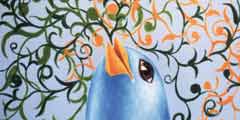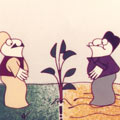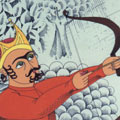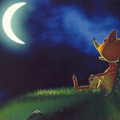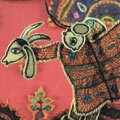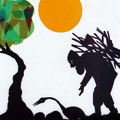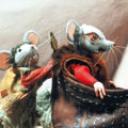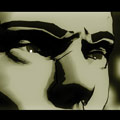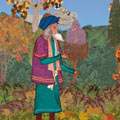This tribute presents a great selection of short animated films made by the Institute for the Intellectual Development of Children and Kids. Kanoon (known on this way throught the world) is a governmental institution established in the 1960’s, and provided a wide range of cultural and artistic activities for children and kids.
A selection of the most beautiful work of Iranian modern animation from a prominent distribution and animation centre in Iran, the DEFC (Documentary and Experimental Film Center) and the Saba Center, a television active in the production of short films and cartoons.
Saeed Tavakolian, teacher at the Animation Department of the Islamic Republic of Iran Broadcasting (IRIB) Faculty, will meet the FFF’s public in a event about the importance of animation Iranian cinema.
The FFF programme follows:
KANOON
The Axe (Tabar)
by Ahmad Arbani (1981, 9’)
An evil hatchet is a danger for a beautiful and flourishing wood. This hatchet begins to destroy trees, bushes and flowers. The individual efforts against the hatchet fail but when the whole forest discovers the power of the group, the hatchet is destroyed.
The Apple Tree (Derakhtè Sib)
by Parviz Naderi (1982, 7’5’’)
An apple tree grows between two private properties. The two owners are not able to decide the possession of the tree, so they share the apples fairly. But they dispute when they have to share fruits and they destroy the tree. The loss of the tree teaches them the importance of the condivision.
Playmate (Hambazi)
by Mohammad-Reza Abedi (1989, 16’)
A red puppet feels alone and she would like to have a friend to play with her, so she makes a blue puppet. When the puppet is ready, she destroys her selfishly. Late, to fight her solitude, she begins to make different animals, but no animal wants to become her friend. Finally, the red puppet decides to make the blue puppet again and, this time, the two puppets play together with happiness.
Malek Khorshid
by Ali Akbar Sadeghi (1975, 16’)
A prince falls in love with a very beautiful woman after have seen her portrait. The love for her drives him to begin a long trip.
Jewel Mountain (Kuhè giavàher)
by Abdollah Alimorad (1994, 27’)
A boy works in a charcoal pit. Where he lives, there is a famous jeweller’s shop. The boy passes along the jewelry every day and emulates dandy boy who works there. But suddenly he’ll understand that the jeweller is not the person he thought.
The Seven Cities (Haft Sciahr)
by Ali Akbar Sadeghi (1971, 15’2’’)
The story allegorically refers to the seven stages of love based on “Seven cities of love” depicted by Attar, the great Iranian poet. The time, in the guise of an aged knight, goes on a long journey. When he arrives at the seventh city, the City of Love, he is astonished and dejected to see its loneliness and gloominess.
The Rook (Rokh)
by Ali-Akbar Sadeghi (1974, 10’31’’)
A chessboard is the only witness to the events. Chessmen move, take shape until the board is bared exept for two pieces, which remain on the board. The game continues…
Zaal and Simorgh
by Ali-Akbar Sadeghi (1977, 26’30’’)
Saam Nariman, the most powerful man, longs for a son to rule over Zabolestan after him. Eventually, his wife gives birth to a son; but the baby is an albino; this makes Sam very furious; he calls the baby a “demon child” and commands his son to be put in a place no one can find him. Simorgh, the wise bird, finds the innocent baby on the heights of Alborz and brings him up.
Flower Storm (Golbàràn)
by Ali-Akbar Sadeghi (1972, 12’)
Two neighbor towns live in peace and security near each othe, but, the friendship between the two rulers is suddenly marred over the appropriation of a hunted bird and hatred grows in the hearts of the people of the two pays and the friendship between them is vanished.
The children of the two towns who see peace is in danger set out to find a solution: they turn weapons into songs.
But, when the people of the two pays want to share the cooked bird between themselves, again their friendship turns to enmity.
Bazaar (The Parrot and te Grocer)
by Abdollah Alimorad (1991, 30’)
The grocer in a big bazaar has a parrot. The sweet talking parrot is very well-known among the people in the bazaar.
One day, after a misunderstanding, the grocer gets furious and punishes the parrot and it’s hurt.
The sadness of the parrot makes everybody unhappy; the whole bazaar becomes silent.
Finally, the people of the Bazaar try to bring them together..
A Raven Who Wanted to Be the Most Powerful (Kalàghi ke mikhàst ghavitarin bàsciad)
by Mohammad-Ali Soleymanzadeh (1999, 12’)
A raven who whishes to be the most powerful, fights with every creature and overcomes all of them.
Then comes one day when he sees his reflection in the water.
He fights with it, but with no success. When he gets completely tired, he falls down the ground, and his fellow creatures come to his help.
Shangoul and Mangoul
by Farkhondeh Torabi & Morteza Ahadi (2000, 17’ 30’’)
It depicts how the wolf deceives the little goats and enters their home when the mother goat is out, how he eats two of them and how they are saved with the help of the little of the family.
Bahador
by Abdollah Alimorad (2000, 27′)
A young mouse that works for a tyrannical ruler, finally finds out that the mice are not equal in social rights, so he tries to help the oppressed ones.
The Farmer and the Cow (Kesciàvarz va gàv)
by Fatemeh Goudarzi (2003, 6’)
A dream-like narration about a farmer and a cow.
The Flower, the Bird and the Sun (Gol va Parandè va Khorscid)
by Bahram Javaheri (2001, 11’)
The sunflower, growing in the shade of a wall is deprived of sunlight; the beast and the butterflies don’t fly near the sunflower. Eventually, a bird advises the flower that it has to grow to a height above the wall on order to reach the sunlight.
Sidewalk (Piàde ro)
by Farshid Shafaiei (2003, 8’)
This film depicts the relationship between the members of a family (the father, the mother, and the son).
The Path of Love (Safar-è Bidàri)
by Morteza Ahadi (2004, 16’)
Hod-Hod witnesses the fight among birds for food. On hearing a tune calling them towards light, a group of birds along with Hod-Hod set out to that direction. To take the journey, they have to go through seven ordeals. Simultaneously, it is a journey within.
There Was The Moon and the Fox (Màh bud va rubàh)
by Babak Nazari (2005, 12’ 30’’)
A fox, so much in love with the moon, takes it away with himself.
The White Winged (Bal-haieh sepid)
by Abdollah Alimorad (2003, 14’)
Two white birds spend a cheerful time in nice spring, but by the arrival of autumn, it becomes hard to find something edible.
The hunger forces them to go to a swamp full of worms and dirt. They know eating such a dirty thing will humiliate them.
The Sweet Story (Hekà-iat scirin)
by Mohammad-Reza Abedi (1995, 15’)
An old woodcutter takes a wounded stork to his home and tends to treat her wounds. In return the stork brings him three watermelon seed. The old man plants the seeds and raises a watermelon which is filled with gold.
The Rainbow Fish (Màhieh ranghin kamàn)
by Farkhondeh Torabi (1996, 13’)
Her coneit makes the beautiful rainbow fish become alone and her being alone makes her an easy prey to enemy fish. However, the other fish help to save her.
The Flow (Jariàn)
by Ali-Reza Chtaei (2003, 3’30’’)
The silence in the campaign, the humming of stone in the river, and the flying of a butterfly.
Lili Lili Little Pool (Lili lili hozak)
by Vajiollah Fardmoghadam (1992, 16’)
The naughty chicken falls into the pool, The hen and the cock ask the others for help, but they have their own problems. Finally, there comes a hope for rescue.
The General and the Kite (General va badbadak)
by Mohammad Ali Soleymanzadeh (2004, 14’30’’)
A general knows himself as the source of power. This is his clothes which make him look as if powerfull. The power of the general without the formal clothes is null, and finally the clothes become a game tool for children.
What Is It Like? (Ci messleh ci)
by Ali Khodaei (2004, 2’30’’)
The story is based on the resemblance of various objects with the animals; a teapot reminds us of a hen and all the things a hen can do; a suger bowl reminds us of a frog that plays and songs with a teaspoon.
The Mouse and the Apple Tree (Musce va derakhteh sib)
by Nahid Samadi - Amin (2003, 6’30’’)
A mouse is trying to pick an apple from the tree, but with no success. He is envy of other animals who can do it easily. Finally, a seal arrives and helps the mouse to pick the rest of the apples from the tree.
Returning Home (Bazgasht be khaneh)
by Behzad Farahat (2004, 12’)
The little hedgehog has a special interest in the nature; its sounds, beauty, and any movement. Once the little hedgehogs are lost in a thick fog, the sounds and sings of the nature help the curious hedgehog to find their way back home.
One Is Not Enought (yeki kam ast)
by Abdollah Alimorad (1998, 25’)
A lazy country boy had nothing but a hen. One day, the poor hungry hen flies into the neighbor’s house to find something to eat. When the boy goes to the next-door to take back his hen, the neighbor’s wife gives him two eggs. This makes the greedy boy to play tricks for gettign more and more eggs.
Bird of Silence (Parande-ieh sokut)
by Lisa Jamileh Barjesteh (2005, 7’)
The film is a symbol of living like a bird.
The Thirsty Crow (Kalàgheh tesceneh)
by Farkhondeh Torabi (1995, 6’)
A thirsty crow in her pursuit for water in a desert, finds a water jar, but there is just a little water and the crow’s beak is too short.
The Lonely Cockoo (Fakhteh-ie Tanhà)
by Parvin Tajvid (1995, 9’)
A lonely cuckoo, who doesn’t like her own singing, tries to imitate others. But she being fun off by other birds, which makes her to forget her own singing. Finally, with hearing another cuckoo’s voice, she realize her voice is better than any other bird.
DEFC
Cup Fortunetelling (Fal-e-ghahen)
by Sara Saiedan (2004, 4’)
Due donne stanno predicento il futuro quando uno dei loro figli viene coinvolto in una una immaginifica vicenda.
Whisper of Existence (Zemzemeye hasti)
by Hassan Zaryabi (2006, 8’)
In a strange city humans don’t have direct relations. The interior voice of a single person is able to change averything and people begin finally to meet each other.
It Happened in Three Seconds (Dar 3 saniyeh etefagh oftad)
by Hossein Ziaei (2004, 13’ 24’’)
In a very cold night a lonely man is coming back to his house. Suddenly he sights a strange light.
Pat (Paat)
by Amirali Baroutian (2005, 25’)
The arrangement of a very famous Iranian tale whose main character is a homeless dog.
One Minute to Hell (Yek daghighe ta jahanam)
by Bozorgmehr Hosseinpour (2005, 1’)
The Hole (Hofreh)
by Vahid Nasirian (2004, 6’)
While a man is walking through the desert he observes that some strange hands are rising from the earth.
Another Beginning (Aghazi digar)
by Maryam Abouzari (2006, 5’)
A man, hurted during the Iraq War, wants to go home but he changes idea after talking with his mother.
Smoky Fish (Mahi doudi)
by Fima Emami (2005, 6’)
Original visual solutions for a nice tale about a group of fishes.
Birth (Tavalod)
by Hoda Mokarami (2006, 7’)
A pregnant woman is singing a lullaby while out if her house the war begins.
Fifi Stories (Majarahaye fifi)
by Hassan Saroughi (2004, 8’)
Fifi is always connected the whole day at the computer until this begins to turn into a real kind of dependence.
A Little Piece (Teke koucholo)
by Farnoush Abedi Zamani (2004, 8’)
A fragment of an object is searching his place in the world.
SABA CENTER
Crows (Kalaghha)
by Zohal Razavi (2006)
Storia di un gruppo di corvi pasticcioni, che alla fine riescono a portare buon umore a tutti.
No Days Hich Rouzi
by Mohammad Reza Khanzad (2006)
Interessante cortometraggio realizzato con la tecnica del dipinto animato
Red Fort (Ghaleye sorkh)
by Farnoush Abedi (2005)
Terrestial (Zamini)
by Hesam Daneshvar e Kianoush Abedi (2005)
The Land (Jegheleh)
by Saied Panji (2005)
Hafiz (Hafez)
by Vahid Nasirian e Saadat Rahimzadeh (2006)
Deserted Restaurant (Resturane matrouk)
by Maryam Abbaspour e Ramak Aminkazemi (2006)
The Hat (Kolah)
by Gholamreza Arjang (2006)
Short realised thanks to the animation tecnhique of the sand . The main character is a gentleman who followa his hat, flyed away with the wind.
No War! (Jang hargez)
by Ravanbakhsh Sadeghi (2005)
From Apple to Apple (Az sib ta sib)
by Babak Nekoui (2006)
Water (Ab)
by Ravanbakhsh Sadeghi (2006)
A short which mix the graphic and narrative technique of the 2D animation with the computer animation’s one.
The Fish (Mahi)
by Mahmoud Fakhrinejad (2006)
Life under the sea realised with the technique of watercolor and indian ink on paper.
